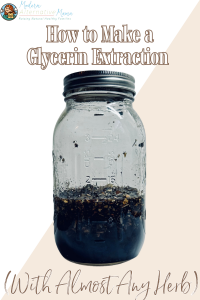By Sarena-Rae Santos, Natural Health Blogger
As a beginner to herbalism, you may want to experiment with every herb under the sun. People often buy popular herbs they see others talking about because they want an entire apothecary, despite not actually needing all the herbs.
Personally, I took a different approach. When I started my herbalism journey, I decided to focus on a specific ailment and find herbs that benefited that ailment. For me, that was lung-supporting herbs.
I chose lung-supporting herbs because I am asthmatic. My dad is also an asthmatic who suffers from COPD. Also, post-covid, my husband and I have struggled with respiratory distress, so why not make our own remedies? I could support three people with one tincture – yes, please!
My starter lung-supporting herbs were mullein, thyme, and marshmallow root.
When I was ready to dab with glycerin extractions, I stuck to a single herb to not overcomplicate the medicine-making process. My first glycerin-based tincture was a simple mullein tincture, which went well. This tincture can be made using either glycerin extraction method mentioned in this post.
Now for the moment, you’ve been waiting for – how to make a glycerin extraction.
How to Make a Glycerin Extraction
If you read our blog, How to Make an Herbal Extraction (With Any Herb), you know glycerin is a less frequently used extraction medium but is growing in popularity. Glycerin extractions, also known as glycerites (or tinctures), are a little similar to alcohol extracts, but there are two methods.
Glycerin can replace alcohol in alcohol extractions. Glycerin is commonly used for children who struggle with the taste of traditional alcohol tinctures or when simply avoiding alcohol. Since there is no alcohol in glycerin extractions, they generally taste sweeter and are easier to take.
There are a few downfalls with glycerin extractions. First and foremost, even following the 1:5 ratio, glycerin-based tinctures are usually not as potent, so larger doses may be required. Secondly, glycerin-based tinctures are sometimes heated up, making this method a little lengthier than an alcohol extraction.
Method One
Method one is the most common glycerin extraction method. This method uses a double-broiler method to simmer fresh or dried herbs in a mixture of glycerin and water for a certain timeframe (usually 2-3 hours). This method creates something similar to decoctions but is more potent because of the glycerin. Method one is said to be more effective (and faster) than the second method but has the same shelf life – about two years.
Let’s discuss step-by-step how to make a glycerin extraction using method one, but first, let’s go over basic supply recommendations.
Recommended Supplies:
- Mason jar
- Herbs of choice (I use Starwest Botanicals or Frontier Co-Op)
- Vegetable glycerin (I recommend this)
- Canning jar lifter (I recommend this)
Step 1: Gather ½ cup of dried or ¾ cup of fresh herbs and chop them up.
Step 2: Mix 1 cup each of filtered water and glycerin in a separate jar. Combine well and pour over herbs.
Step 3: Fill a pot with water and place the jar in the water. Allow to simmer for 2-3 hours.
Step 4: After simmering, strain the mixture through a strainer covered in cheesecloth.
Optional: Some people use a French press to extract the remaining liquid after straining the mixture.
Step 5: Transfer to a dark-colored, glass, airtight container for long-term storage.
Usage & Storage: Take 10-20 drops (1/8-1/4 tsp) 2-3 times daily. It will last about two years when stored in a cool, dark place like a cabinet. If you notice visible mold at the top, it has gone bad.
Method Two
Method two is very similar to alcohol extractions and is made by soaking fresh or dried herbs in glycerin and water (instead of alcohol) for a certain amount of time (usually 4-6 weeks). This method, like an alcohol extraction, should follow the 1:5 ratio. Some herbalists use a 1:3 or 1:4 ratio for harder herbs like roots. Method two, like method one, has a two-year shelf life.
Let’s discuss step-by-step how to make a glycerin extraction using method two, but first, let’s go over basic supply recommendations.
Recommended Supplies:
- Mason jar
- Herbs of choice (I use Starwest Botanicals or Frontier Co-Op)
- Vegetable glycerin (I recommend this)
Step 1: Gather ½ cup of dried or ¾ cup of fresh herbs and chop them up.
Step 2: Mix 1 cup each of filtered water and glycerin in a separate jar. Combine well and pour over herbs.
Step 3: Place the jar in a cool, dark cabinet to steep for 4-6 weeks and shake daily.
Step 4: After steeping, strain the mixture through a strainer covered in cheesecloth.
Optional: Some people use a French press to extract the remaining liquid after straining the mixture.
Step 5: Transfer to a dark-colored, glass, airtight container for long-term storage.
Usage & Storage: Take 10-20 drops (1/8-1/4 tsp) 2-3 times daily. It will last about two years when stored in a cool, dark place like a cabinet. If you notice visible mold at the top, it has gone bad.
Whether you’re a newbie or a seasoned herbalist, I hope this post was able to answer questions you may have had. Remember, herbalism isn’t all or nothing; every herbalist doesn’t look the same. It is okay to start slow, at your own speed, and figure out what works for you. Trial and error is the key, but hopefully, this post takes away most of the errors and leaves you with plenty of successful herbal remedies. Either way, with practice (and time), you’ll be making herbal remedies for everyone in your life in no time.




